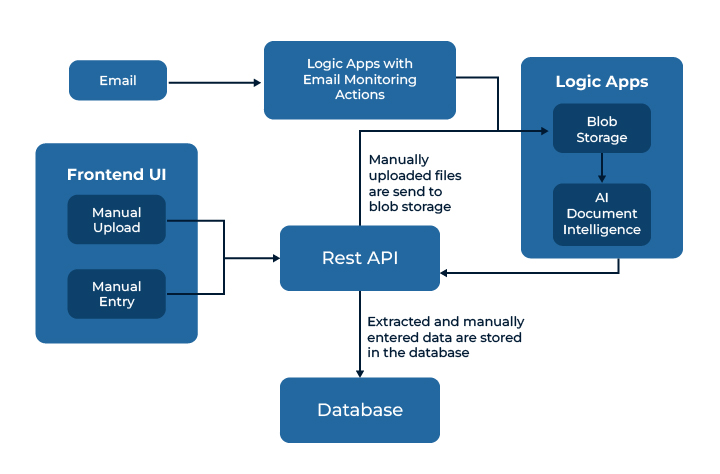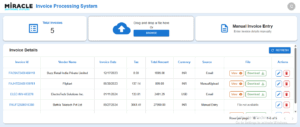Introduction
Invoice processing is a critical function for many organizations, yet it often remains manual and time-consuming. The challenge becomes even greater when finance teams must handle hundreds of vendor invoices arriving through various channels such as email and manual uploads. While assisting a finance team facing this issue, I explored ways to streamline their process. To address these inefficiencies, I developed a software product using Microsoft Azure services to automate invoice intake, extraction, validation, and storage. This blog discovers the solution architecture, workflow, and the key takeaways from this initiative.
The Business Challenge
One of the main difficulties in automating invoice processing lies in the inconsistent format of incoming documents. Invoices may be submitted as PDFs, scanned images, or structured digital documents, each requiring a different approach to extract meaningful data. Key fields like invoice number, vendor name, date, and amount must be accurately identified and parsed. Manual data entry not only extends processing time but also introduces errors.
Why I Built This Solution
The objective was to validate whether Azure’s ecosystem could support an end-to-end automated invoice processing solution. My focus was to minimize manual intervention, improving data accuracy, and ensure timely availability of structured invoice data for the Finance team.
Azure Services and Tech Stack
- Azure Logic Apps: Handles email-based invoice ingestion
- Azure Blob Storage: Stores invoice files securely
- Azure AI Document Intelligence: Extracts structured data from documents
- Azure Communication Services: Sends email notifications
- ASP.NET Core 8 Web API: Manages backend data processing
- React with Material UI: Provides a user-friendly frontend
- Azure SQL Database: Stores extracted invoice data
Workflow Overview
- Invoices are received via email or uploaded manually through the frontend.
- Logic Apps capture email attachments and transfer them to Blob Storage.
- Azure AI Document Intelligence extracts invoice fields such as vendor name, date, amount, and invoice number.
- Extracted data is validated and parsed by the Web API.
- The data is stored in Azure SQL Database.
- Email notifications are sent to the Finance team to indicate success or report errors.

User Interface Highlights
The frontend is built using React and Material UI and provides a simple interface for uploading invoices and reviewing the status of processed documents. Each invoice entry displays details such as vendor name, amount, currency, and source type (email or manual upload).

Backend and API Design
The backend was developed using ASP.NET Core 8 and manages data validation, duplicate checks, and secure storage. To ensure controlled access, time-limited SAS tokens are generated for Blob Storage files.
Implementation Challenges and Resolutions
- Maintaining accuracy when processing diverse and inconsistent invoice formats
- Ensuring secure integration with Azure Blob Storage
- Handling variations in the extracted JSON output
- Delivering clear and actionable error messages for end users
Business Impact
- Reduced manual data entry by over 80%
- Improved data accuracy through AI-driven field extraction
- Enabled real-time access to invoice data for the Finance team
- Built a scalable and extensible architecture suitable for future integration
Planned Enhancements
- Implementing an approval workflow for invoice validation before ERP posting
- Integrating Power BI for real-time dashboards and analytics
- Adding support for multi-currency and multilingual invoices
- Expanding integration to include ERP systems such as SAP and others
Conclusion
This solution showcases the potential of combining Azure services with intelligent document processing to optimize invoice workflows. The Resolution is modular, secure, and ready to scale into a full production system. For organizations seeking to reduce processing time and improve data accuracy, this approach provides a strong foundation for automation.





